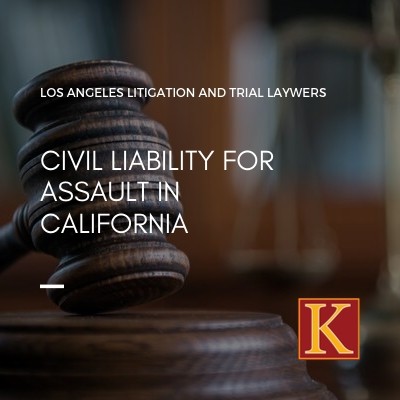Under personal injury law, assault is defined as a purposeful act by one person which causes a reasonable apprehension of immediate harm or offensive contact to another person. Assault is known as an intentional tort when it is made the subject of a civil case.
Elements of Assault
According to CACI 1301 to establish the claim of assault, a plaintiff must prove all the following elements:
- The defendant acted with the intention to cause harmful or offensive contact
- Plaintiff reasonably believed that he was about to be touched in a harmful or offensive manner or threatened to touch in a harmful or an offensive manner
- It reasonably appeared to the plaintiff that the defendant was about to carry out the threat
- Plaintiff did not consent to the defendant’s conduct
- Plaintiff was harmed
- Defendant’s conduct was a substantial factor in causing harm to the plaintiff
Assault does not always involve physical contact, at least not when it comes to civil liability. Even fear of offensive or harmful touching is usually enough for an assault to have occurred. In case the touching actually occurs, the physical contact is usually classified as a battery in civil law, though both claims are often made together.
Difference Between Criminal Assault and Civil Assault in California
Assault can be filed under civil and criminal laws and in both cases the elements to prove are similar. Both require that the defendant’s conduct create a reasonable apprehension of harm to the plaintiff. Though, the difference between criminal assault and civil assault lies mainly in the legal remedies that result from the action.
In civil law, it is required that the defendant either meant to cause apprehension or that the defendant should have known that his conduct would cause apprehension to the plaintiff. In contrast, criminal law requires that the defendant had the intention to commit physical injury or battery to the plaintiff.
In a civil assault claim, it is a private lawsuit between two persons, where a plaintiff can normally collect monetary damages, but a jail sentence is not usually imposed in civil assault claims. In contrast, with a criminal trial, the involved parties are the state (the prosecution) and the victim. Any damages awards can be limited by state statutes that cover how much a victim can recover in a criminal trial. On the other hand, criminal laws generally impose a jail sentence for the defendant, which can range from a few months to several years depending on the severity of the assault.
Legal Defenses to California Civil Assault Claims
- The defendant was acting in self-defense.
In case the defendant was acting in self-defense or defense of another person he can’t be found liable.
- Defendant had a privilege:
In some cases, the defendant could have a limited right to commit assault. For instance, when a peace officer attempts to place a suspect under arrest.
- The plaintiff fails to prove all the necessary elements of the claim:
In a successful claim, the plaintiff must prove all the elements of assault: the apprehension of harm, cause of action and the defendant’s purpose or knowledge of harm to the plaintiff.
Damages that can be recovered
- Economic damages, including medical bills and lost income.
- Non-economic damages including compensation for pain and suffering and other losses which are difficult to quantify
- Punitive damages, designed mainly to punish the assailant.

